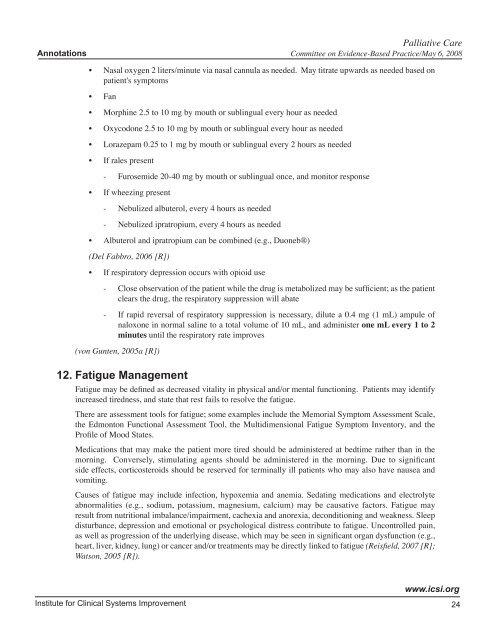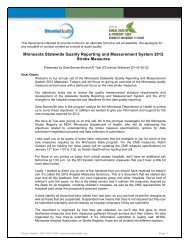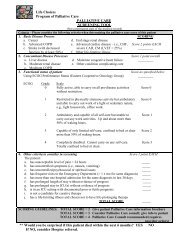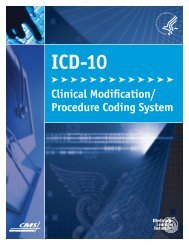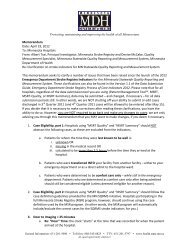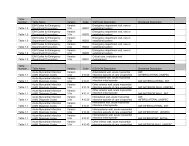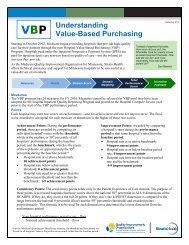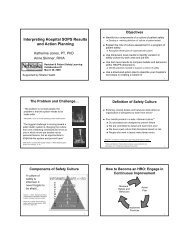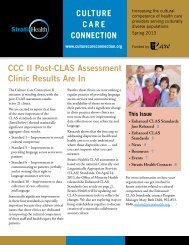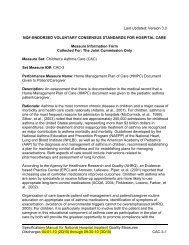Palliative Care Order Set - Stratis Health
Palliative Care Order Set - Stratis Health
Palliative Care Order Set - Stratis Health
You also want an ePaper? Increase the reach of your titles
YUMPU automatically turns print PDFs into web optimized ePapers that Google loves.
<strong>Palliative</strong> <strong>Care</strong><br />
Annotations Committee on Evidence-Based Practice/May 6, 2008<br />
• Nasal oxygen 2 liters/minute via nasal cannula as needed. May titrate upwards as needed based on<br />
patient's symptoms<br />
• Fan<br />
• Morphine 2.5 to 10 mg by mouth or sublingual every hour as needed<br />
• Oxycodone 2.5 to 10 mg by mouth or sublingual every hour as needed<br />
• Lorazepam 0.25 to 1 mg by mouth or sublingual every 2 hours as needed<br />
• If rales present<br />
- Furosemide 20-40 mg by mouth or sublingual once, and monitor response<br />
• If wheezing present<br />
- Nebulized albuterol, every 4 hours as needed<br />
- Nebulized ipratropium, every 4 hours as needed<br />
• Albuterol and ipratropium can be combined (e.g., Duoneb®)<br />
(Del Fabbro, 2006 [R])<br />
• If respiratory depression occurs with opioid use<br />
- Close observation of the patient while the drug is metabolized may be sufficient; as the patient<br />
clears the drug, the respiratory suppression will abate<br />
- If rapid reversal of respiratory suppression is necessary, dilute a 0.4 mg (1 mL) ampule of<br />
naloxone in normal saline to a total volume of 10 mL, and administer one mL every 1 to 2<br />
minutes until the respiratory rate improves<br />
(von Gunten, 2005a [R])<br />
12. Fatigue Management<br />
Fatigue may be defined as decreased vitality in physical and/or mental functioning. Patients may identify<br />
increased tiredness, and state that rest fails to resolve the fatigue.<br />
There are assessment tools for fatigue; some examples include the Memorial Symptom Assessment Scale,<br />
the Edmonton Functional Assessment Tool, the Multidimensional Fatigue Symptom Inventory, and the<br />
Profile of Mood States.<br />
Medications that may make the patient more tired should be administered at bedtime rather than in the<br />
morning. Conversely, stimulating agents should be administered in the morning. Due to significant<br />
side effects, corticosteroids should be reserved for terminally ill patients who may also have nausea and<br />
vomiting.<br />
Causes of fatigue may include infection, hypoxemia and anemia. Sedating medications and electrolyte<br />
abnormalities (e.g., sodium, potassium, magnesium, calcium) may be causative factors. Fatigue may<br />
result from nutritional imbalance/impairment, cachexia and anorexia, deconditioning and weakness. Sleep<br />
disturbance, depression and emotional or psychological distress contribute to fatigue. Uncontrolled pain,<br />
as well as progression of the underlying disease, which may be seen in significant organ dysfunction (e.g.,<br />
heart, liver, kidney, lung) or cancer and/or treatments may be directly linked to fatigue (Reisfield, 2007 [R];<br />
Watson, 2005 [R]).<br />
www.icsi.org<br />
Institute for Clinical Systems Improvement<br />
24


